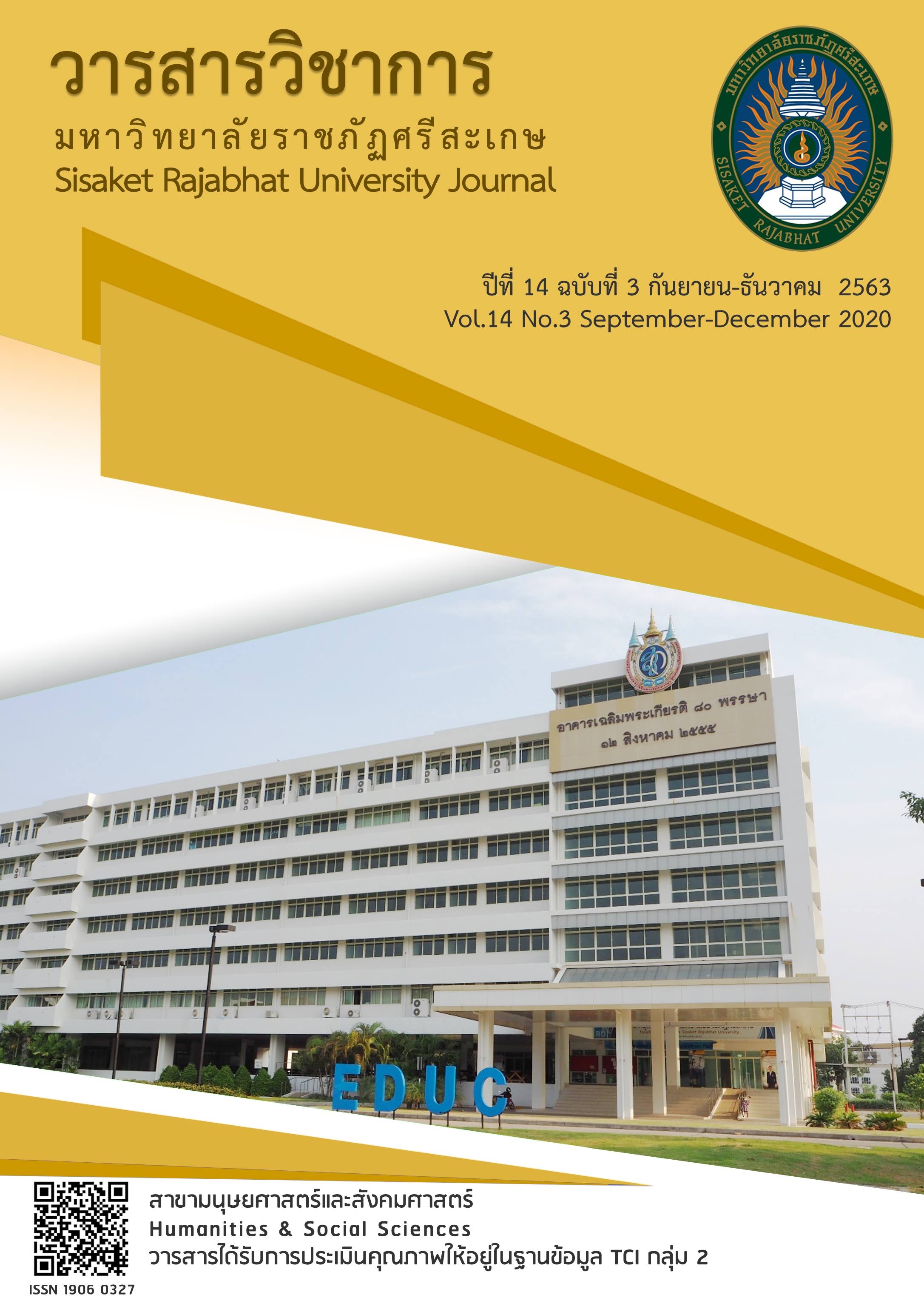ผลการจัดการเรียนรู้เรื่อง การบวก การลบ การคูณ และการหารทศนิยม ตามแนวคิดทฤษฎีคอนสตรัคติวิสต์ของ Underhill ร่วมกับเทคนิคการวาดรูป บาร์โมเดล ที่มีต่อผลสัมฤทธิ์ทางการเรียน และความสามารถใน การคิดวิเคราะห์ของนักเรียนชั้นประถมศึกษาปีที่ 6
Main Article Content
บทคัดย่อ
การวิจัยครั้งนี้จัดทำขึ้นเพื่อหาผลการจัดการเรียนรู้เรื่อง การบวก การลบ การคูณ และ การหารทศนิยม ตามแนวคิดทฤษฎีคอนสตรัคติวิสต์ของ Underhill ร่วมกับเทคนิคการวาดรูปบาร์โมเดล ที่มีต่อผลสัมฤทธิ์ทางการเรียน และความสามารถในการคิดวิเคราะห์ กลุ่มตัวอย่างที่ใช้ในการวิจัยครั้งนี้ ได้แก่ นักเรียนที่กำลังศึกษาอยู่ในระดับชั้นประถมศึกษาปีที่ 6 โรงเรียนวัดบ้านเมืองโพธิ์ จำนวน 1 ห้อง จำนวน 28 คน ซึ่งได้มาจากวิธีการสุ่มแบบแบ่งกลุ่ม เครื่องมือที่ใช้ในการวิจัยประกอบด้วย 1) แผนการจัดการเรียนรู้ จำนวน 16 แผน 2) แบบทดสอบวัดผลสัมฤทธิ์ทางการเรียน เป็นแบบปรนัย ชนิดเลือกตอบ 4 ตัวเลือก จำนวน 30 ข้อ 3) แบบทดสอบวัดความสามารถในการคิดวิเคราะห์ เป็นแบบอัตนัย จำนวน 5 ข้อ ตามทฤษฎีการคิดวิเคราะห์ของมาร์ซาโน สถิติที่ใช้ในการวิเคราะห์ข้อมูล ได้แก่ ร้อยละ ค่าเฉลี่ย ส่วนเบี่ยงเบนมาตรฐาน และทดสอบสมมติฐานด้วยสถิติ การหาค่า t แบบ Dependent Sample t-test และ One Sample t-test
ผลการวิจัย สรุปได้ว่า 1. ผลสัมฤทธิ์ทางการเรียนหลังเรียน สูงกว่าก่อนเรียนอย่างมีนัยสำคัญทางสถิติที่ระดับ .05 2. ผลสัมฤทธิ์ทางการเรียนหลังเรียนสูงกว่าเกณฑ์ร้อยละ 70 อย่างมีนัยสำคัญทางสถิติที่ระดับ .05 3. ความสามารถในการคิดวิเคราะห์หลังเรียนสูงกว่าก่อนเรียนอย่างมีนัยสำคัญทางสถิติที่ระดับ .05 4. ความสามารถในการคิดวิเคราะห์หลังเรียนสูงกว่าเกณฑ์ร้อยละ 70 อย่างมีนัยสำคัญทางสถิติที่ระดับ .05
Article Details
1. เนื้อหาและข้อมูลในบทความที่ลงตีพิมพ์ในวารสารวิชาการมหาวิทยาลัยราชภัฏศรีสะเกษ ถือเป็นข้อคิดเห็นและความรับผิดชอบของผู้เขียนบทความโดยตรง ซึ่งกองบรรณาธิการวารสาร ไม่จำเป็นต้องเห็นด้วย หรือร่วมรับผิดชอบใด ๆ
2. บทความ ข้อมูล เนื้อหา รูปภาพ ฯลฯ ที่ได้รับการตีพิมพ์ในวารสารวิชาการมหาวิทยาลัยราชภัฏศรีสะเกษ กองบรรณาธิการไม่สงวนสิทธิ์ในการคัดลอกบทความเพื่อการศึกษา แต่ให้อ้างอิงแหล่งที่มาให้ครบถ้วนสมบูรณ์
เอกสารอ้างอิง
Bloom, B. S. (1956). Taxonomy of Educational Objective Book 1: Cognitive Domain. London: Longman Group.
Brooks, J.G., & Brooks, M.G. (1993). The Case for Constructivist Classroom. Virginia:
Association for Supervision and Curriculum Development.
Kerry, L., Jeremy, N. & Fannie, K. (2013). "Longer Bars for Bigger Numbers?
Children's Usage and Understanding of Graphical Representations of Algebraic
Problems. Journal of Frontline Learning Research 1. 1(1): 81-96.
Kevin, M. (2012). Singapore's Math Training. Retrieved 12 October 2019, from
http://www.singaporemath.com/Articles,asp?ID=281.
Lee, Y. M. (2014). Mathematical Problem Solving: The Bar Model Method. Singapore
: Scholastic Education International (Singapore) Private Limited.
Marzano, R.J. (2001). Designing a New Taxonomy of Educational Objective. Thousand Oaks, California: Cowin Press, Inc.
Ministry of Education. (2017). Indicators and Subjects of Learning Mathematics Core
Group. (Revised Version 2017) According to the Core Curriculum of Basic Education Year 2008. Bangkok: Printing House, Agricultural Cooperative Federation of Thailand, Ltd. [In Thai]
Nualuetai, L. (2015). Organizing Learning Activity for Problem Solving Development by Polyas Problem Solving Processes Co-Operate with Bar Model for Second Grade Students. (M.Ed. Curriculum and Instructions). Seattle: Chiang Rai Rajabhat University. [In Thai]
Office of the Basic Education Commission. (2017). Indicators and Subjects of Learning
Mathematics Core Content (2017 edition) According to the Basic Education
Intermediate Curriculum 2008. Bangkok: Printing House, Agricultural Cooperative Federation of Thailand, Ltd. [In Thai]
Piratorn, T. (2013). The Development of Mathematics Learning Activities Based on
Constructivist Theory of Underhill's Instructional Model Emphasizing Analytical Thinking Skills and Utilizing the Geometer's Sketchpad as a Learning Tool about Solving Equations and Inequalities Using Graphs for Mattayomsuksa 4. (M.Ed. Curriculum and Instruction). Seattle: Khon Kaen University. [In Thai]
Siriphan, S. (2017). The Development of Mathematics Learning Activities Based on the Constructivist Instructional Model Emphasizing Analytical Thinking Skills on Addition, Subtraction, Multiplication and Division of Fractions for Pratomsuksa 5. (M.Ed. Curriculum and Instruction (M.Ed. Curriculum and Instruction). Seattle: Khon Kaen University. [In Thai]
Srisuwan, S. (2013). Development of Activity-Based Learning Mathematics. According to the Theory of Learning and Constructivist to Promote the Ability to Solve Problems and Achievement of Students at Prathomsuksa 5. (M.Ed. Curriculum and Instruction). Seattle: Mahasarakham University. [In Thai]
Underhill, G.R. (2002). Radical Constructivism in Mathematics Education. New York Kluwer.


